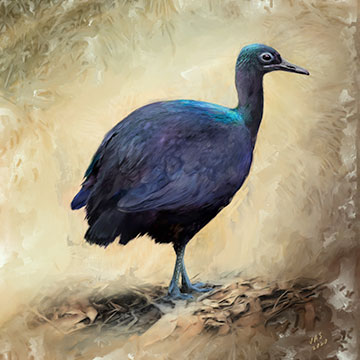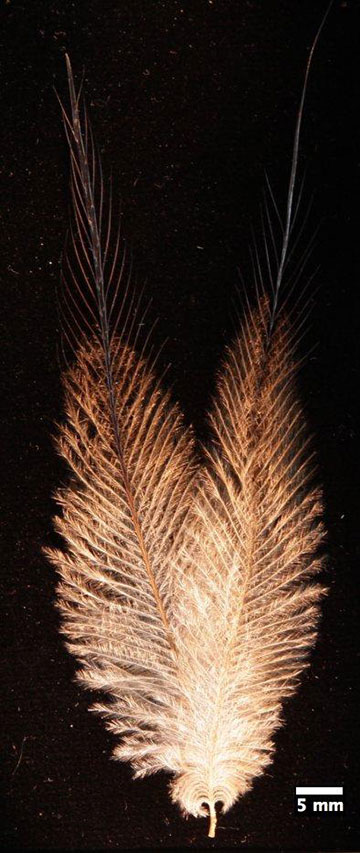
An illustration of Calciavis, an early relative of ostriches and cassowaries that lived 52 million years ago, showing its iridescent feathers. [Image: Velizar Simeonovski]
Cassowaries are large, flightless birds and close cousins of emus. With their three-toed, clawed, dinosaur-looking feet and their bright blue heads each topped with a fan-shaped helmet, the birds make a strong—albeit terrifying—impression. Yet it’s their glossy feathers that recently caught the attention of two U.S. researchers.
In their study, Chad Eliason of the Field Museum in Chicago, IL, and Julia Clarke at the University of Texas Austin, TX, detail a novel form of structural color in these striking birds (Sci. Adv., doi: 10.1126/sciadv.aba0187). The researchers, who study structural color in birds as well as dinosaurs, also looked at 52-million-year-old fossils of cassowaries’ long-extinct ancestors and uncovered another example of structural color, raising some interesting evolutionary questions.
Avian evolution
There are two living clades of birds—palaeognaths, including emus, ostriches and cassowaries, and neognaths, which include essentially all other birds, like songbirds, ducks and chickens. This deep divide in the avian world can be traced back to about 80 million years ago. And while scientists have found evidence of microstructures on feathers creating iridescent colors in neognaths, structural coloration hasn’t been observed in the oft-overlooked sister clade.
However, lead author Chad Eliason points out, it’s important to study both lineages “because it gives us a better idea of how evolution works.” Understanding how color is generated in living animals can inform ideas of how color evolves, and even how extinct species may have looked. Although palaeognaths represent only about 60 modern species, understanding these traits is important, says Eliason, because they’re “the sister lineage to the other 10,000-plus birds that we know today.”
The gloss factor

Microscopic detail of a cassowary feather, showing the exposed rachises that allow for iridescence. [Image: Chad Eliason]
The recent study began with a simple question: What gives cassowaries their signature shine? This simple question could have any of several answers—birds produce color through many mechanisms, including pigments like melanin, which are produced in the parts of the cells called melanosomes, and various structural-color mechanisms that depend on the shape and structure of their feathers. Bird feathers have a branching structure of barbs and barbules (the smallest part of the feather, which contain melansomes) that extend from the central rachis of the feather, or shaft.
To get to the bottom of this question, Eliason and Clarke quantified the feather gloss by measuring specular and diffuse reflectance. “A key attribute of structural gloss and iridescent colors,” explains Eliason, “is the dynamic nature of changes in reflectance with viewing angle and light incident angle.”
The two researchers then imaged cassowary feathers using atomic force microscopy (AFM) and transmission electron microscopy (TEM), not finding any clear nanoscale features to which they could attribute the gloss. Next, they used light microscopy to investigate the microstructural details of cassowary feathers. And here, they found the truth of why cassowaries shine.
For other birds with similar glossy feathers, the sheen is attributable to a keratin film in the feather barbules or flattened feather barbs—both of which increase reflected light. Eliason and Clarke’s results, however, revealed a different form of structural color, which they dubbed “structural gloss.” Cassowaries, they found, have narrow feathers with large, bare rachises which reflect more light directionally and increase specular reflectance. To their knowledge, this is the first example of rachis-based structural color in birds.
Flashy fossils
The team then shifted its focus to the past—52 million years ago, give or take. Eliason and Clarke studied extinct lithornithid specimens, focusing on fossil melanosome morphology to get a better idea of color evolution in these distant cousins of cassowaries. They chipped off tiny flakes from the dark spots of melanin preserved in the fossil and took a closer look at the ancient melanosomes using scanning electron microscopy. “These images alone don't tell us much,” explains Eliason, “but when we compare them statistically to the melanosomes forms in modern bird species whose color is known, we can make inferences about the likely color patterns in the extinct bird.”
What they found were long, skinny melanosome shapes that are associated with iridescence in modern birds—a different form of structural color than cassowaries’ structural gloss. “From an evolutionary standpoint,” says Eliason, “this tells us that this group of birds (palaeognaths) have a much greater amount of diversity in these flashy traits than was previously realized.”
